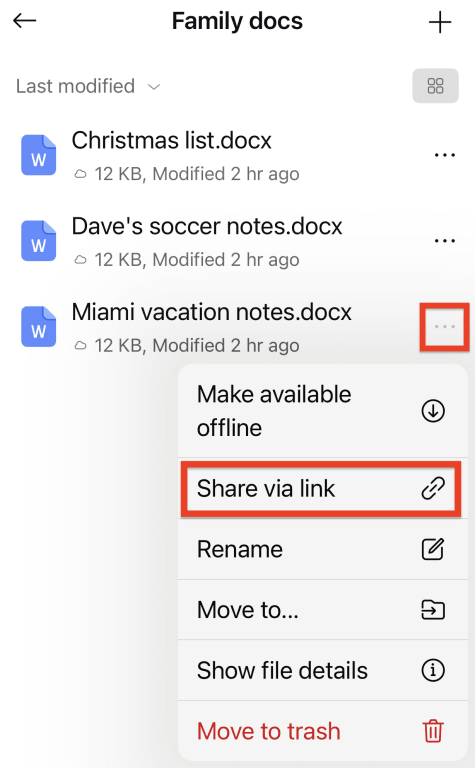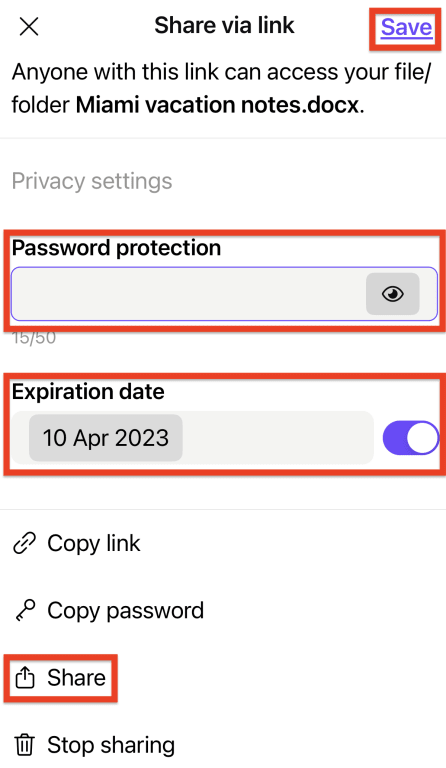Die meisten E-Mail-Dienste sind nicht sicher und begrenzen die Größe von Anhängen, doch es gibt Wege, um große Dateien sicher zu versenden.
Wenn du schon einmal versucht hast, mehrere Bilder oder Videodateien als E-Mail-Anhang zu versenden, weißt du, dass das nicht immer funktioniert. Wir erklären Wege, um große Dateien sicher zu versenden, einschließlich des kostenlosen Teilens großer Dateien.
Kannst du große Dateien per E-Mail sicher versenden?
4 Wege, um große Dateien sicher zu versenden
1. Sicherer Cloud-Speicher
2. Datei-Transfer-Dienste
3. FTPS
4. Entfernbare Speichermedien
Große Dateien sicher und kostenlos teilen

Kannst du große Dateien per E-Mail sicher versenden?
Du kannst große Dateien als E-Mail-Anhänge versenden, aber E-Mails haben zwei wesentliche Einschränkungen.
Zum einen ist die maximale Größe von E-Mail-Anhängen begrenzt. Du kannst beispielsweise Anhänge bis zu 25 MB mit Gmail und Proton Mail versenden.
Zweitens sind E-Mails nicht sicher genug, um sensible Dateien zu versenden, es sei denn, du verwendest Ende-zu-Ende-verschlüsselte E-Mails, wie Proton Mail. Die meisten großen E-Mail-Anbieter, wie Gmail und Outlook, verwenden TLS-Verschlüsselung(neues Fenster), um deine E-Mails auf dem Transportweg zu schützen. Deine E-Mails sind beim Versand sicher, wenn der E-Mail-Dienst des Empfängers TLS unterstützt. Sobald sie jedoch angekommen sind, hängt die Sicherheit deiner Nachrichten davon ab, welche Verschlüsselung der empfangende Server verwendet.
Du kannst deine E-Mail-Anhänge verschlüsseln, um sie sicherer zu machen und größere Dateien zu komprimieren, um sie innerhalb der Anhangsgrenzen zu versenden. Aber es gibt praktischere Wege, um große Dateien sicher zu versenden.
4 Wege, um große Dateien sicher zu versenden
Hier sind einige einfache Methoden, um große Dateien mit jedem zu teilen, obwohl nicht alle gleichermaßen sicher oder praktisch sind.
1. Sicherer Cloud-Speicher
Der praktischste und sicherste Weg, um große Dateien zu versenden, ist die Verwendung von sicherem Cloud-Speicher. Anstatt die Dateien als E-Mail-Anhang zu versenden, sendest du einen Link zu ihnen, wie dieses Beispiel von Proton Drive.

Die Person, an die du schreibst, muss nur auf Alle herunterladen klicken, um die Dateien zu empfangen.
Beliebte Cloud-Speicherdienste wie Google Drive, Microsoft OneDrive oder Dropbox ermöglichen es dir, Dateien über einen Link zu teilen. Die meisten Cloud-Speicherdienste behalten jedoch die Verschlüsselungsschlüssel für deine Dateien, was bedeutet, dass Dritte darauf zugreifen können. Außerdem begrenzen einige Cloud-Dienste die Größe der Dateien oder Ordner, die du teilen kannst.
Um Dateien beliebiger Größe zu teilen und sicherzustellen, dass nur du und von dir autorisierte Personen darauf zugreifen können, probiere Proton Drive mit Ende-zu-Ende-Verschlüsselung aus.
2. File-Transfer-Dienste
Es gibt mehrere spezialisierte File-Transfer-Dienste wie WeTransfer, die es dir ermöglichen, größere Dateien ähnlich wie Cloud-Speicherdienste zu senden. Wie bei Google Drive verwenden die besten Dienste eine starke Verschlüsselung, wie TLS, um deine Daten zu verschlüsseln.
Allerdings behalten, wie bei Google Drive, die Anbieter die Verschlüsselungsschlüssel für deine Dateien, was bedeutet, dass sie auch deine Dateien entschlüsseln können. Und einige kostenlose Versionen sind eingeschränkt und bieten keinen Passwortschutz für Links oder die Möglichkeit, eine Zeit festzulegen, bevor deine Dateien gelöscht werden.
Insgesamt sind deine Dateien nicht Ende-zu-Ende-verschlüsselt, sodass du nicht die vollständige Kontrolle darüber hast, wer darauf zugreifen kann.
3. FTPS
Wenn du technisch versiert bist oder große Dateien bei der Arbeit übertragen möchtest, könntest du das File Transfer Protocol (FTP)(neues Fenster) verwenden. Obwohl FTP ursprünglich nicht für Sicherheit ausgelegt war, gibt es sicherere Versionen.
Zum Beispiel verschlüsselt File Transfer Protocol Secure (FTPS) Verbindungen mit TLS und kann mit kostenlosen FTP-Clients wie FileZilla(neues Fenster) verwendet werden. Dein Arbeitsplatz verwendet möglicherweise bereits FTPS oder Ähnliches für große Datei-Übertragungsaufgaben.
Obwohl FTPS eine sichere Methode zum Teilen oder Senden großer Dateien ist, wenn es richtig eingerichtet wird, ist es kompliziert einzurichten und nur praktisch, wenn du weißt, was du tust.
4. Abnehmbare Speichermedien
Die einfachste Möglichkeit, eine große Datei oder einen Ordner an jemanden zu senden, mit dem du direkt in Kontakt stehst, ist die Verwendung eines USB-Laufwerks. Kopiere einfach die Datei oder den Ordner auf das Laufwerk und übergib es ihnen oder sende es mit einem sicheren Kurier.
Aber bevor du das tust, stelle sicher, dass du dein USB-Laufwerk verschlüsselst und es mit einem starken Passwort schützt, falls es verloren geht.
Abgesehen vom Risiko des physischen Verlusts besteht der Hauptnachteil beim Teilen von Dateien mit abnehmbaren Speichermedien darin, dass du die Kontrolle über deine Dateien verlierst, sobald du sie weitergegeben hast. Du kannst das Teilen von Dateien nicht stoppen oder sie ferngesteuert ändern, wenn du sie aktualisieren musst.
Große Dateien sicher und kostenlos teilen
Eine einfache und sehr sichere Methode, um große Dateien zu senden, ist die Verwendung von Proton Drive. Du kannst Dateien und Ordner jeder Größe mit wenigen Klicks sicher mit jedem teilen.
Mit Proton Drive werden deine Dateien Ende-zu-Ende-verschlüsselt. Das bedeutet, nur du und diejenigen, mit denen du teilst, können sie sehen. Niemand sonst hat Zugriff, nicht einmal Proton. Und Proton Drive ist in der Schweiz ansässig, daher werden deine Daten durch einige der weltweit strengsten Datenschutzgesetze geschützt.
Wenn du Dateien mit Proton Drive teilst, kannst du:
- Dateien und Ordner mit Passwort schützen: Sichere deine Freigabelinks mit einem starken Passwort.
- Freigabezeitlimits festlegen: Lege ein Ablaufdatum für die Dateifreigabe fest.
- Überwachung und Beenden der Freigabe: Verfolge die Anzahl der Downloads und widerrufe den Zugriff mit einem Klick.
- Dateien von überall teilen: Lade dir die Proton Drive Mobile-Apps für all deine Geräte herunter, um jederzeit auf Dateien zuzugreifen, sie zu aktualisieren und unterwegs zu teilen.
Um beispielsweise eine Datei von deinem iPhone zu teilen, öffne einfach die Proton Drive-App, wähle das horizontale Menü mit den drei Punkten neben einer Datei und wähle Über Link teilen.

Lege ein Passwort und ein Ablaufdatum fest (falls nötig) und tippe auf Speichern. Tippe dann auf Teilen, um einen sicheren Link zur Datei per Proton Mail oder einem anderen E-Mail- oder Nachrichtendienst deiner Wahl zu senden.

Proton Drive beinhaltet kostenlosen Zugang zu Ende-zu-Ende-verschlüsseltem Proton Mail, Proton Calendar und Proton VPN(neues Fenster), und du kannst mit bis zu 1 GB Speicherplatz kostenlos starten.
Wenn du mehr Speicherplatz möchtest oder unser Ziel unterstützen willst, jedem Online-Privatsphäre und Sicherheit zu bieten, kannst du einen kostenpflichtigen Plan wählen. Gemeinsam können wir ein Internet aufbauen, in dem Privatsphäre der Standard ist.
